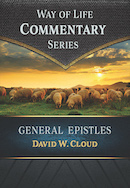866-295-4143, fbns@wayoflife.org
Though all bird sounds are typically categorized as “songs,” a distinction should be made between true songbirds and other birds that make various noises. For example, most ducks, eagles, and hawks are not songbirds. They quack or screech, but they don’t sing.
I suspect that bird calls are often lumped into the “song” category because of the evolutionary philosophy underlying the field. It is assumed that the purpose for all bird noises, regardless of how pretty and complicated, is for such things as territorial marking and mating which supposedly acted as conditions for “natural selection.” Evolutionists even theorize that the true song birds are more highly evolved (Les Beletsky, Bird Songs from Around the World, 2007, p. 7).
While there is no doubt that bird songs mean something to birds, the Bible believer knows there is more to it than this. Evolutionists are blind to the fact that pretty bird song has a much higher purpose, and that is to glorify the Creator and to please man, the crown of creation (Psalm 8:4-8).
Some birds have truly amazing musical abilities.
Pliny the Elder said in Naturalis Historia “that the song of the Nightingale was equal in beauty to any musical instrument that man could produce” (Beautiful Bird Songs from Around the World, British Library, 2008).
Percy Shelley described the Skylark’s song as ‘a rain of melody’ in his poem “To a Skylark.” “Anyone who has stood beneath an ascending Skylark in full song will immediately appreciate this fitting description” (Beautiful Songs).
Many composers have transcribed birdsong.
“Ornithologists have known for some time that bird songs use the same musical scales as our music. Decades ago it was noted that some of Beethoven's work could be heard from the European blackbird. The music was the same as the opening rondo of Beethoven's ‘Violin Concert in D, Opus 61.’ Since these birds pass their songs from generation to generation, Beethoven could have gotten the lilting music from the forefathers of today’s European blackbird! The songs of some species, like the song sparrow, follow the form of a sonata, beginning with a strong theme, then the theme is musically played with, and for a finish, the original theme is then repeated. Mozart had a starling as a pet. Once, having heard Mozart play his ‘Piano Concerto in C Major,’ the starling not only imitated it, but changed the sharps to flats! Mozart exclaimed, ‘That was beautiful!’ When the starling died, Mozart held an elaborate funeral for it. Eight days later he wrote ‘A Musical Joke,’ which contains the same elaborate structure found in starling song” (Creation Moments, May 12, 2010, citing “Music without Borders,” Science News, April 15, 2000, pp. 252-254).
“French composer Olivier Messiaen (1908-1992) ... dedicated much of his career to studying and expressing the musicality of birdsong. One of his most famous and ambitious pieces is the Catalogue d’oiseaux, a seven-book set of portraits that captures the spirit of species such as the Woodlark, Reed Warbler and Blue Rock Thrush” (Beautiful Songs).
Birds have two sets of membranes in their syrinx (voice box) so that they can produce independent sounds in two voices at once.
“Birds vocalize with the syrinx, a sound-producing organ located at the junction of the two bronchi at the base of the trachea. These two bronchial sides can actually be stimulated independently, so they can each produce different sounds at the same time, as happens in the clear, flutelike song of the Wood Thrush” (Bird Songs: 250 North American Birds in Song, foreword by Jon Dunn, p. 6).
Birds can take mini-breaths that are so brief and so perfectly synchronized with their songs they do not produce any discernible gaps in their songs.
“Birds give the impression of singing in long bursts for minutes on end without catching their breath. But they actually do this by taking a series of shallow mini-breaths, which are synchronized with each syllable they sing” (Gareth Davies, “Bird Songs,” pbs.org, n.d., http://www.pbs.org/lifeofbirds/songs/index.html, retrieved Oct. 13, 2010).
The nightingale has a repertoire of 100-300 songs.
A chaffinch can sing up to 45 notes per second and there can be several hundred notes per song (Stuart Burgess, Hallmarks of Design).
Some birds transpose songs from one key to another.
Others sing the same song in a variety of voices.
Some birds sing DUETS. These include the Australian magpie, Eastern whipbird, African shrike, African robin-chat, passerine, plain-tailed wren of Ecuador, California towhee, Long-tailed manakins, Buff-breasted wren, Rufous-and-white wren (Thryothorus rufalbus), Panama bay wren, Marsh wren, and the African shrike.
Some birds engage in countersinging and antiphonal singing, with one bird singing part of a song and the other bird singing another part, moving back and forth, possibly spontaneously composing “variations on a theme.”
Some pairs of songbirds, such as the African shrike, African robin-chat and Eastern whipbird (of Australia) perform this type of singing.
Antiphonal singing requires knowledge of the duet by both partners and split-second timing in its execution.
The whip-crack sound made by the male Eastern whipbird is actually a very rapidly ascending or descending whistle. Amazingly, the whistle stretches from 500 to 8000 Hz in just 0.1 seconds. The female often adds two notes to the end of the male’s whistle.
Some birds even sing MATCHED DUETTING in a group of four.
“The two pairs of courting birds will deliberately compose a song with four parts over a period of time. The songs are often very beautiful, with great musical structure, and involve split-second timing of the four participants.”
Matched duetting was discovered by a team of researchers in 2002 among the plain-tailed wrens (Thryothorus) in Ecuador.
As the morning mists rose on the slopes of Ecuador's Pasochoa volcano, the burbling of plain-tailed wrens came through the bamboo thickets. Two researchers started their standard procedure of catching wrens, banding them, and letting them go. Soon, however, they were startled when a small cluster of wrens settled into a bush and began singing together. It turned out to be ‘one of the most complex singing performances yet described in a nonhuman animal,’ says Nigel Mann.
“This social oddity has musical consequences. Often, three or more birds sing—males, then females, then males, and so on—to produce what sounds like a single melody.
’It's quite difficult to work out what's Charlie's contribution, what's Mary's,’ Mann says. Yet the scientists did work out the score. At rare moments in the several weeks of observation, Mann or Dingess picked up clues to which bird was singing when one singer perched closer to the microphone than the rest of the chorus did.
From these hard-won moments, the researchers realized that songs typically repeat four phrases: ABCDABCD.... Only males sing the As and Cs, and only females sing Bs and Ds. Each singer knows 25-to-30 variations on each of its two possible parts, and for each variation of A, a particular variation of B usually follows, as do particular Ds after Cs.
When more than two birds strike up a tune, they double up on the parts so precisely that if one bird stops singing, the tune keeps going. The males sing the same variation of A with precise timing, followed by the females chorusing the same version of B, then back to the males for the same C, and so on. The parts shift back and forth at least twice a second.
It's the first four-part, synchronized chorus with alternating parts recorded outside human music, Mann, Dingess, and Peter J.B. Slater of the University of St. Andrews in Scotland report in the March 22 Biology Letters. And when one considers the split-second alternation, the birds' singing surpasses human vocal virtuosity (Susan Milius, “Just Duet,” BioMusica.blogia.com, 2002).
“The white-crested laughing thrush also sings a group chorus. Each individual has its own phrase to contribute to the song: the result is like one bird singing. White-browed sparrow weavers sing group choruses, which they use to defend their territories. Remarkably, each bird is an expert sound mixer. It can also produce the whole chorus on its own. The sound produced by one individual will sound as complex as that produced by nine” (Gareth Davies, “Bird Songs,” http://www.pbs.org/lifeofbirds/songs/index.html, retrieved Oct. 13, 2010).
(The idea that the weavers are using the choruses to defend their territories is speculation, based on evolutionary assumptions that bird song evolved through natural selection.)
Some birds are adept at mimicking other birds.
A mockingbird was recorded in Arizona singing a series of different songs for 90 seconds without repeating any one song.
A Crissal Thrasher was recorded in Arizona imitating the following birds in one session: Killdeer, Red-tailed Hawk, Western/Cassin's Kingbird, Lesser Goldfinch, Mockingbird, Plain Titmouse, Flicker, House Sparrow, American Robin, Sparrow Hawk, Abert's Towhee, and Song Sparrow.
Some birds can even recreate other sounds in nature and man-made noises. Starlings in the Shetland Islands can mimic sheep. The Australian lyrebird, the king of feathered mimics, can imitate such things as the whirring of a camera’s motor drive and shutter, car engines and alarms, rifle-shots, explosions, a baby’s cry, a dog’s bark, and the screech of a chainsaw. There is a sound clip online of Chook, a lyrebird at the Adelaide Zoo, imitating the sound of construction equipment (http://www.youtube.com/watch?v=WeQjkQpeJwY). See also http://www.bbc.co.uk/nature/life/Superb_Lyrebird.
These amazing feats require not only a wonderfully-designed voice box but also marvelous intelligence, not only to control the voice apparatus but also to identify and recall them.
- Receive these reports by email
- www.wayoflife.org
______________________
Sharing Policy: Much of our material is available for free, such as the hundreds of articles at the Way of Life web site. Other items we sell to help fund our expensive literature and foreign church planting ministries. Way of Life's content falls into two categories: sharable and non-sharable. Things that we encourage you to share include the audio sermons, O Timothy magazine, FBIS articles, and the free eVideos and free eBooks. You are welcome to make copies of these at your own expense and share them with friends and family. You may also post parts of reports and/or entire reports to websites, blogs, etc as long as you give proper credit (citation). A link to the original report is very much appreciated as the reports are frequently updated and/or expanded. Things we do not want copied and distributed are "Store" items like the Fundamental Baptist Digital Library, print editions of our books, electronic editions of the books that we sell, the videos that we sell, etc. The items have taken years to produce at enormous expense in time and money, and we use the income from sales to help fund the ministry. We trust that your Christian honesty will preserve the integrity of this policy. "For the scripture saith, Thou shalt not muzzle the ox that treadeth out the corn. And, The labourer is worthy of his reward" (1 Timothy 5:18). Questions? support@wayoflife.org
Goal:Distributed by Way of Life Literature Inc., the Fundamental Baptist Information Service is an e-mail posting for Bible-believing Christians. Established in 1974, Way of Life Literature is a fundamental Baptist preaching and publishing ministry based in Bethel Baptist Church, London, Ontario, of which Wilbert Unger is the founding Pastor. Brother Cloud lives in South Asia where he has been a church planting missionary since 1979. Our primary goal with the FBIS is to provide material to assist preachers in the edification and protection of the churches.
Offering: Offerings are welcome if you care to make one. If you have been helped and/or blessed by our material offerings can be mailed or made online with with Visa, Mastercard, Discover, or Paypal. For information see: www.wayoflife.org/about/makeanoffering.html.





